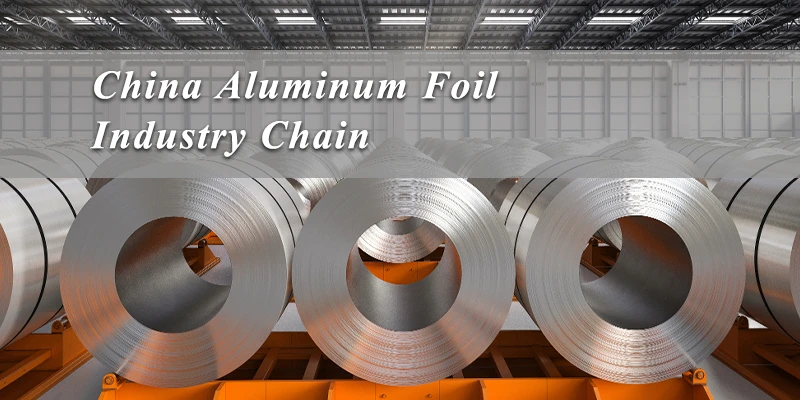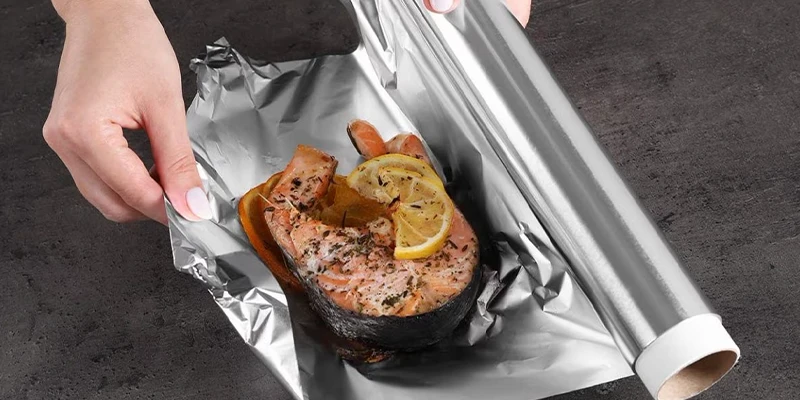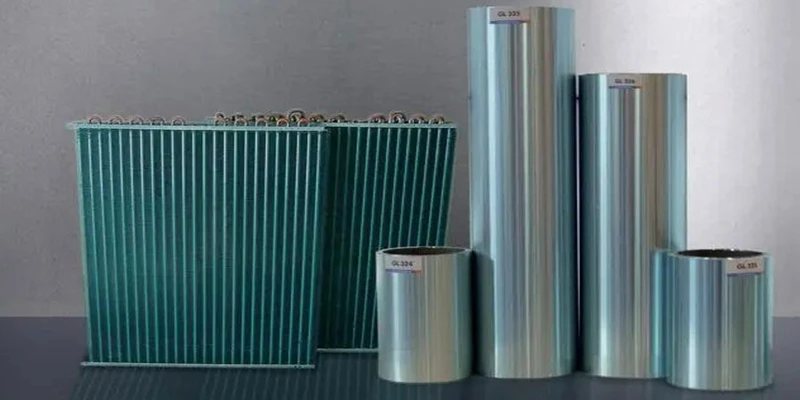The aluminum foil industry chain is divided into raw material supply and manufacturing, aluminum foil manufacturing, and demand industries. There are many aluminum foil production enterprises in China and they are widely distributed. Relatively speaking, there are many aluminum foil factories in provinces such as Sichuan, Guizhou, and Henan.

The specific process of aluminum foil production is converting bauxite into alumina, and then using alumina as raw material to produce raw aluminum by high-temperature electrolysis.
After adding alloys to the electrolyzed aluminum, it is processed into giant rolls of aluminum foil through extrusion, rolling, etc., which are widely used in packaging, air conditioning, electronics and other fields. According to the main application of aluminum foil, aluminum foil enterprises are divided into air conditioning aluminum foil manufacturers, packaging aluminum foil manufacturers, electronic foil manufacturers and container foil manufacturers.
Development History of China’s Aluminum Foil Industry
1932 to 1960
In the early 20th century, China’s tobacco industry was booming, and there was a great demand for aluminum foil for cigarette packaging, but at that time, aluminum foil was all imported. In 1930, three aluminum companies from Canada, Switzerland and the United Kingdom used the old equipment eliminated by Swiss Aluminum Company to build China’s first aluminum foil factory in Shanghai, named Shanghai Steel Factory (later renamed Shanghai Aluminum). In December 1932, Shanghai Steel Factory was put into production with only 127 employees in the early stage. Later, it gradually developed into a complete aluminum plate, strip and foil production enterprise.
1961 to 1980
In 1959, Liaoning Electronic Aluminum Foil Factory was put into operation with a production capacity of 900 tons/year. In 1961, Shanghai Aluminum Factory tried to produce pure aluminum plates for toothpaste tubes, and the aluminum foil produced began to be exported in the same year, but the production volume of aluminum foil did not increase significantly. In 1962, Northeast Light Alloy Aluminum Co., Ltd. put into operation the aluminum foil workshop built in imitation of the Shanghai Steel Precision Factory model, with a production capacity of 1,500 tons/year. In 1976, the Ministry of Metallurgical Industry approved the Northeast Light Alloy Company to add an aluminum foil section. Aluminum processing plants such as the Northwest Aluminum Processing Plant were also built and put into production during this period, and the foil production capacity continued to increase.
1981 to 1999
In 1980, China introduced the first advanced four-roll 1200m universal foil rolling mill from West Germany’s Aschenbach Company, with a production capacity of 900 tons/year. In 1981, the North China Aluminum Processing Plant began to build the second phase project and introduced a batch of advanced aluminum foil production equipment and technology. In 1984, the first Sino-foreign joint venture in China’s aluminum industry, “Zhongri Zhuoshenyou Metal Processing Special Equipment Co., Ltd.” was established. During this period, China’s aluminum processing industry introduced a large number of advanced technologies and equipment, and its production capacity and product quality continued to improve.
2000 till now
After entering the 21st century, China’s aluminum foil industry has continued to maintain a high-speed development trend and gradually become the leader of the global aluminum foil market. In 2004, China’s aluminum exports exceeded imports for the first time, achieving net exports. In 2006, China’s aluminum foil output reached 7.88 million tons, surpassing the United States to become the world’s largest aluminum foil producer. In 2007, China became one of the world’s primary aluminum foil powers.
Development Status of China’s Aluminum Foil Industry
China is the world’s largest producer and consumer of aluminum foil. With the increasing awareness of environmental protection and demand for sustainable packaging, the market demand for aluminum foil, as a recyclable, lightweight material with good barrier properties, continues to rise. At the same time, the rapid development of the electronics, new energy cycling and energy storage industries has also increased the demand for high-performance aluminum foil.
According to data from the China Nonferrous Metals Industry Association, China’s aluminum foil production has continued to rise in recent years. In 2019, China’s aluminum foil production was 4 million tons. By 2023, my country’s aluminum foil production will reach 5.1 million tons, up 1.6% year-on-year from 2022.
In terms of the import and export of aluminum foil (HS code: 7607), China is a major producer and supplier of aluminum foil in the world. Currently, nearly one-third of my country’s aluminum foil production is for the export market. In 2020, China imported a total of 77,000 tons of aluminum foil and exported a total of 1.239 million tons of aluminum foil. In 2021, China imported about 85,000 tons of aluminum foil and exported 1.335 million tons of aluminum foil.
Three Major Areas of China’s Aluminum Foil Industry
Currently, packaging foil, air-conditioning foil and battery foil are the three major consumer markets for aluminum foil applications in China, among which the packaging industry is the industry with the largest consumption and export in China.
Packaging aluminum foil
Currently, most metal packaging foils are made of aluminum foil, and aluminum is the fourth most used material in China’s packaging industry.
The packaging industry is an important production industry that provides important supporting packaging services for domestic and export products. Data shows that in 2021, China’s packaging industry enterprises above designated size achieved a total operating income of 1,204.181 billion yuan, a year-on-year increase of 16.39%; the total profit was 71.056 billion yuan, a year-on-year increase of 13.52%.

Air conditioning aluminum foil
Air conditioning aluminum foil is a material used to make the fins of air conditioning heat exchangers. Aluminum foil has been used in the production of air conditioning heat exchangers in my country for more than 20 years and has developed rapidly in the past 10 years. The current thickness is only between 0.09 and 0.15 mm.

Battery foil
Battery foil is the fastest growing aluminum foil product in 2021. Moreover, battery foil is mostly used in lithium battery manufacturing. As the scale of new energy vehicle industry expands, the market demand for lithium batteries is getting higher and higher, and battery foil consumption is the highest.
China’s Key Aluminum Foil Companies
| Company Name | Business |
| Henan Yongsheng Aluminum | Aluminum foil products cover batteries, air conditioners, packaging, hookahs, medicines, etc., and also include aluminum foil container series. |
| Jiangsu Dingsheng New Materials | Dingsheng New Materials has advantages in battery aluminum foil. Its battery foil products have uniform thickness, good surface quality, and high conductivity, which can meet the manufacturing needs of different types of batteries. |
| Jiangsu Changlu Aluminum Co., Ltd. | In terms of aluminum foil business, it covers the fields of air conditioning foil, pharmaceutical aluminum foil, etc. It has a certain scale of production capacity in China to mainly meet the needs of the domestic air conditioning and pharmaceutical industries. |
| Southwest Aluminum | The company produces aluminum foil for aerospace, which has extremely high requirements on material strength, corrosion resistance and precision. Southwest Aluminum also engages in the field of high-end electronic aluminum foil, providing high-precision and high-performance aluminum foil products for the electronic information industry. |
| Henan Mingtai Aluminum | They produce various types of aluminum foil, including packaging aluminum foil, building aluminum foil, etc. We occupy a large share in the domestic aluminum foil market. We improve our market competitiveness by improving production efficiency and reducing costs. |
| Xinjiang Zhonghe Co., Ltd. | Develop aluminum foil business based on high-purity aluminum. Produce high-end aluminum foil products such as electronic aluminum foil. Its electronic aluminum foil has advantages in purity and internal structure, which can meet the needs of high-end electronic component manufacturing, especially in the production of high specific capacitance electronic aluminum foil. |
Future Development
High-end
- High-end aluminum foil products have higher technical content and added value, and can meet customers’ higher requirements for quality and performance. In the future, the aluminum foil industry will pay more attention to technology research and development and innovation, and continuously launch new high-end aluminum foil products, such as aluminum foil with special properties such as high strength, high conductivity, and high corrosion resistance.
- These products will be widely used in aerospace, new energy vehicles, high-end packaging and other fields, bringing new growth points to the aluminum foil industry. At the same time, high-end will also promote technological progress and industrial upgrading of the aluminum foil industry, and enhance the competitiveness of the entire industry.
Production intelligence
- With the rapid development of technologies such as the Internet of Things, big data, and artificial intelligence, the aluminum foil industry will gradually realize the intelligence and automation of the production process. By introducing advanced intelligent equipment and systems, real-time monitoring and control of the production process can be achieved, and production efficiency and product quality can be improved.
- At the same time, intelligent production can also reduce production costs and energy consumption and enhance the competitiveness of enterprises. In the future, the aluminum foil industry will pay more attention to the application and promotion of intelligent technology to promote the intelligent transformation of the industry.
Diversified demand
- Different fields have different requirements for the performance, specifications, and uses of aluminum foil products, requiring the aluminum foil industry to provide diversified products and services. For example, in the packaging field, aluminum foil needs to have good barrier properties, freshness preservation, and recyclability; in the new energy field, aluminum foil needs to have high conductivity, high strength, and light weight.
- In the future, the aluminum foil industry will pay more attention to market research and customer demand analysis, and continuously adjust product structure and service models according to changes in market demand to meet the diverse needs of customers.



